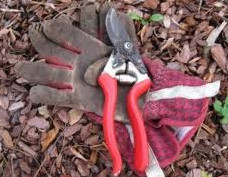
Some plants will require special care during the cooler months.
If the forecast is anticipating freezing temperatures, there are some necessary steps to ensure your flower beds will survive.
Keeping the soil moist helps to prevent cold air from permeating it, thus damaging tender roots.
Mulching also retains heat and moisture, providing an additional level of protection for your garden.
Keeping Plants Warm
When freezing temperatures are predicted, cover tender plants with fabric or paper or plastics; however, if plants are covered in a non breathable material, be sure to uncover them first thing in the morning. If you don’t uncover them first thing, the plants may suffocate.

I personally suggest using burlap for trees and shrubs.
Hardy perennials (what is a perennial) would actually be well taken care of by the winter itself if they were covered in a mask of snow.
The problem comes when there might be a little snowfall but it doesn’t really stick or simply just darn cold, which then brings the frost. This unmerciful force of cold temperatures can kill many plants and trees even if they are hardy (i.e. ready for the cold).
Avoid Root Rot
Be very careful if your landscape has a poor drainage system. If snow melts and the water sits on your soil for too long, what can happen is something we call root rot. I’m sure you can tell just from the words that “root rot” is not something we want to happen and can kill your plants.
One thing I suggest you do if your trees and shrubs are relatively young (or recently transplanted) is to water them deeply before the winter cold freezes the ground (see also our irrigation article). You can even take it a step further and spray your evergreens with a sealant called, Wilt-Pruf, which helps lock in moisture.
Create a Blanket for the Ground
What do you do when you’re in the house, on the couch and cold? You cover up, right?
So if the ground outside is going to freeze, guess what you can do to help keep it warm? Cover it!

Grab yourself a little more of that burlap we talked about earlier and use it as a blanket on the ground in sensitive areas around your plants.
If you don’t have burlap or something else to cover the ground with, use what you can find in nature:
- leaves
- ground bark (shredded preferred, but chipped will do)
- straw
- pine needles
Be creative if you have to, just make sure the ground surrounding your plants doesn’t freeze if at all possible.
Block the Cold Wind
Okay so it’s cold out, but what makes it feel even colder? Wind.
If at all possible, try to cover your smaller plants with some kind of windbreak. Use a helmet, towel, bag, pot, or whatever. Feel free to be creative here. Don’t forget, though, that plants need to breathe too, so make sure if what you’re using restricts airflow too much that you uncover it during the warmer part of the day for a bit. Also, the reverse is true. Don’t let the cover overheat your plant when the sun comes out.
Knock Snow Off Branches
A little bit of snow doesn’t weigh much, but a lot of snow on leaves and branches can begin to weigh down the branches of your trees and shrubs. If they become too heavy, the branches could break under the stress.
Gently knock off piles of snow from the branches starting from the bottom and working your way up. Be gentle, though, you don’t want to break the branches yourself.
If you have delicate tropicals, however, keep in mind that they will need to be dug up and stored in a greenhouse or some other shelter no later than November 1st of every year. These kinds of plants may not harden enough for the winter cold.

Maintenance
There also are a few points in maintenance that coincide directly with winter.
First off, don’t prune in the Fall. When you prune a plant, it encourages new growth. The new growth will be susceptible to the extreme temperatures of winter.
Secondly, avoid applying fertilizers that are high in nitrogen during the Fall. The nitrogen also encourages new growth, which is unwanted just before winter.
Keep these points in mind when gardening in Houston during the colder months. A heavy tropical landscape will entail a lot of work to preserve the plants over winter. Plant tender varieties alongside areas that offer protection from the elements, such as fences, walls and sturdy shrubs. Educate yourself of the species you chose for your garden, and be prepared for any additional care that may be needed over the winter months.

